Scroll through the lesson and click on notation/video/audio links to load the interactive players.
Please subscribe to get full access to all lessons for only $7.95/month PLUS 1 week free trial.

Riff Interactive lessons are
LESS expensive and
MORE interactive than alternatives!
More Info
|
|
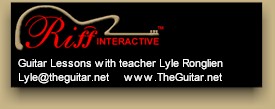
Billy Gibbons (ZZ Top)
Style
Lesson 4
Lyle:
You'll be working in the key of G for this lesson, standard tuning. Learn this
first blues rhythm riff:
Lyle:
Try to palm mute the 6th string during all the single notes. Rest the heal of
your picking hand on the end of the 6th string like in this picture:
palm
mute
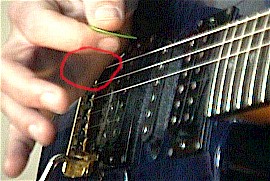
Sean: there is a GOD after hearing that
riff
Lyle:
Now use this jam track to play the riff you just learned:
Lyle:
There are a total of 3 chords for the progression you'll be learning, the G, and
a C riff starting at the 8th fret:
Lyle:
Here's the rhythm riff for A:
Sean: very
cool
Lyle: All the same riffs, just played at
different places on the neck. Put the 3 chord rhythm riffs together in a
progression like this:
Lyle:
This 12 bar blues progression is a little different than the standard "1-4-5"
progression. Most of the time, a 12 bar blues in G would use the G, C, and D
chords, the 1-4-5 of G. Here the 5 chord (D) isn't used at all!
12 bar blues chord
chart
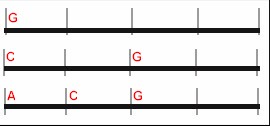
Lyle: Now use this jam track to play all 3 rhythm
riffs with:
Lyle:
Besides the last jam track that's just drums and bass, you can use this other
jam track which has another rhythm guitar part you'll learn next:
Lyle:
Billy Gibbons, from ZZ Top, used overdubs in the studio to create fatter
sounding rhythm tracks. You've just learned rhythm riff 1 with the tight palm
mute and slight overdrive added, now I'd like to show you rhythm riff 2.
Lyle:
Here's rhythm riff 2 for the G chord:
dand: would
this be called a 1-4-2 progression?
Lyle: You may call it that. It's just like a
standard 12 bar blues progression, but the V chord is replaced with the II
chord.
Lyle: For these rhythm riffs, try using an ultra
clean tone with a little chorus added. Here's how you'll play the C and A chords
for the progression:
Jim: Wouldn't
the A -> C then be like a II V to the G? Nice
resolution.
Jim:
(Ah, except it isn't II V ... sorry, nevermind)
Lyle:
Examine this next tab file to learn where to play the new rhythm riffs 2 at:
Lyle:
Here's the chord chart again so you don't have to scroll back up the page:
12 bar blues chord
chart
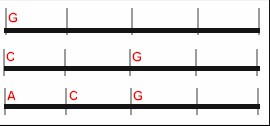
Lyle: So you see how two simple rhythm riffs
played together can create a huge sound, each rhythm riff is played very tight
and exact, one with a little overdrive, one ultra clean.
Lyle:
Now play the clean rhythm riffs 2 along to this jam track which has rhythm riff
1 that you learned earlier:
Lyle:
I've got a few solo riffs to show you. They are in the Gm pentatonic
scale:
Lyle:
Notice the massive vibrato in this first riff:
Lyle:
Riff 2 is the G minor pentatonic scale descending:
Lyle:
Riff 3 starts out using a "car horn" lick, 2 notes played together, a whole step
apart:
PhilW: Do you
vibrate just the B string?
Lyle: I try to wiggle both
strings.
PhilW:
Ah, I can see it a little in the video.
Lyle: Ok, about the tones....I used a Rocktron
Voodu Valve directly into my pc to record the guitar parts.
Voodu Valve
rack
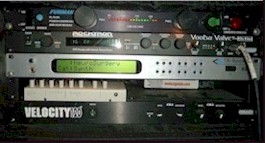
Lyle: Rhythm riff 1 was on a preset titled SRV
for a tight, non effect sound with a little overdrive to it,
Lyle:
Rhythm riff 2, the clean part was a preset called "warm jazz chorus" like the
old Roland Jazz Chorus amps, and the solo riffs came from a preset called "STP"
which had a tube overdrive set for soft clip, then chorus added.
Lyle:
Here's the ending riff that you'll play during the last 2 measure of the
progression, called a turn around riff
Lyle:
Here's another jam track with both rhythm riffs in it:
Lyle:
That's all for this lesson tonight.
Lyle: Good time for me to take a break.
|
<< load notation from left
|
|
<< load audio from left
|
<< load audio from left
|